Machine-Milking Practices, Animal Welfare-Related Reactions and Quality of Milk Produced in Dairy Sheep Farms
Simple Summary
Abstract
1. Introduction
2. Materials and Methods
2.1. Farms
2.2. Details of Visits
2.3. Sample Collection and Examination
2.4. Data Management and Analysis
3. Results
3.1. Descriptive Results
3.1.1. Time Intervals
3.1.2. Animal Reactions
3.1.3. Somatic Cell Counts and Total Bacterial Counts
3.2. Predictors for Animal Reactions During the Milking Process
3.2.1. Proportion of Ewes That Displayed the Reactions ‘Kneeling’ Before Entry to the Milking Pen and ‘Kneeling’ Within the Milking Pen
3.2.2. Proportion of Ewes That Urinated or Defaecated
3.2.3. Display of Vocalisation by Ewes
3.2.4. Proportion of Ewes That Displayed Kick-like Reaction, That Attempted to Remove the Milking Cluster (Or Removed It) and That Showed Spot-Stepping
3.2.5. Total Number of Distinct Reactions That Were Observed on Ewes on a Farm During the Milking Session
3.3. Predictors for Somatic Cell Counts and Total Bacterial Counts
3.3.1. Somatic Cell Counts
3.3.2. Total Bacterial Counts
3.4. Recapitulation
3.5. Correlations Between Animal Reactions and Characteristics of Bulk-Tank Milk
4. Discussion
4.1. Preamble
4.2. Comments on Potential Limitations
4.3. Reactions of Animals Recorded During the Milking Process and Potential Predictors
4.4. Somatic Cell Counts and Total Bacterial Counts and Potential Predictors
5. Conclusions
Supplementary Materials
Author Contributions
Funding
Institutional Review Board Statement
Informed Consent Statement
Data Availability Statement
Conflicts of Interest
References
- Kilgour, R. The open-field test as an assessment of the temperament of dairy cows. Anim. Behav. 1975, 23, 615–624. [Google Scholar] [CrossRef]
- Tüfekci, H.; Sejian, V. Stress factors and their effects on productivity in sheep. Animals 2023, 13, 2769. [Google Scholar] [CrossRef]
- Blokhuis, H.J.; Hopster, H.; Geverink, N.A.; Korte, S.M.; Van Reenen, C.G. Studies of stress in farm animals. Comp. Haematol. Int. 1998, 8, 94–101. [Google Scholar] [CrossRef]
- Yardimci, M.; Sahin, E.H.; Cetingul, I.S.; Bayram, I.; Aslan, R.; Sengor, E. Stress responses to comparative handling procedures in sheep. Animal 2013, 7, 143–150. [Google Scholar] [CrossRef]
- Unsal, G.; Johnson, K.F.; Stergiadis, S.; Bennett, R.; Barker, Z.E. A systematic review and meta-analysis of physical environmental enrichment to improve animal welfare-related outcomes in indoor cattle. Anim. Welf. 2025, 34, e37. [Google Scholar] [CrossRef]
- Lawrence, A.B.; Terlouw, E.M.C.; Illius, A.W. Individual differences in behavioural responses of pigs exposed to non-social and social challenges. Appl. Anim. Behav. Sci. 1991, 30, 73–86. [Google Scholar] [CrossRef]
- Dwyer, C.M. The Welfare of Sheep; Springer Science: Dordrecht, The Netherlands, 2008; p. 366. [Google Scholar]
- Grandin, T.; Shivley, C. How farm animals react and perceive stressful situations such as handling, restraint, and transport. Animals 2015, 5, 1233–1251. [Google Scholar] [CrossRef]
- Van Reenen, C.G.; Van Der Werf, J.T.N.; Bruckmaier, R.M.; Hopster, H.; Engel, B.; Noordhuizen, J.P.T.M.; Blokhuis, H.J. Individual differences in behavioral and physiological responsiveness of primiparous dairy cows to machine milking. J. Dairy Sci. 2002, 85, 2551–2561. [Google Scholar] [CrossRef] [PubMed]
- Saltalamacchia, F.; Tripaldi, C.; Castellano, A.; Napolitano, F.; Musto, M.; De Rosa, G. Human and animal behaviour in dairy buffalo at milking. Anim. Welf. 2007, 16, 139–142. [Google Scholar] [CrossRef]
- Cavallina, R.; Roncoroni, C.; Campagna, M.C.; Minero, M.; Canali, E. Buffalo behavioural response to machine milking in early lactation. It. J. Anim. Sci. 2008, 7, 287–295. [Google Scholar] [CrossRef]
- Andrioli, M.; Grajales-Cedeño, J.K.; Sant’Anna, A.C.; Negrão, J.A.; Paranhos da Costa, M.J.R. Milking reactivity in primiparous saanen goats during early lactation: Effects on milk yield, milk quality and plasma cortisol concentration. Animals 2024, 14, 3365. [Google Scholar] [CrossRef] [PubMed]
- Kézér, F.L.; Kovács, L.; Tőzsér, J. Step behaviour and autonomic nervous system activity in multiparous dairy cows during milking in a herringbone milking system. Animal 2015, 9, 1393–1396. [Google Scholar] [CrossRef] [PubMed]
- Hemsworth, P.H.; Coleman, G.J.; Barnett, J.L.; Borg, S. Relationships between human-animal interactions and productivity of commercial dairy cows. J. Anim. Sci. 2000, 78, 2821. [Google Scholar] [CrossRef]
- Munksgaard, L.; DePassillé, A.M.; Rushen, J.; Herskin, M.S.; Kristensen, A.M. Dairy cows’ fear of people: Social learning, milk yield and behaviour at milking. Appl. Anim. Behav. Sci. 2001, 73, 15–26. [Google Scholar] [CrossRef]
- De Rosa, G.; Napolitano, F.; Grasso, F.; Pacelli, C.; Bordi, A. On the development of a monitoring scheme of buffalo welfare at farm level. It. J. Anim. Sci. 2005, 4, 115–125. [Google Scholar] [CrossRef]
- Faid-Allah, E.; Mourad, R.S.; Saddick, E.I.; Eldahshan, E. Managerial factors affecting milking-abilities of Holstein cattle under intensive production system in Egypt. Trop. Anim. Health Prod. 2025, 57, 23. [Google Scholar] [CrossRef]
- Rushen, J.; Munksgaard, L.; Marnet, P.G.; DePassillé, A.M. Human contact and the effects of acute stress on cows at milking. Appl. Anim. Behav. Sci. 2001, 73, 1–14. [Google Scholar] [CrossRef]
- Pacheco, H.A.; Hernandez, R.O.; Chen, S.Y.; Neave, H.W.; Pempek, J.A.; Brito, L.F. Phenotyping strategies and genetic background of dairy cattle behavior in intensive production systems—From trait definition to genomic selection. J. Dairy Sci. 2025, 108, 6–32. [Google Scholar] [CrossRef]
- Carcangiu, V.; Arfuso, F.; Luridiana, S.; Giannetto, C.; Rizzo, M.; Bini, P.P.; Piccione, G. Relationship between different livestock managements and stress response in dairy ewes. Arch. Anim. Breed. 2018, 61, 37–41. [Google Scholar] [CrossRef]
- European Food Safety Authority. Scientific opinion on the welfare risks related to the farming of sheep for wool, meat and milk production. EFSA J. 2014, 12, 3933–4060. [Google Scholar] [CrossRef]
- Lianou, D.T.; Chatziprodromidou, I.P.; Vasileiou, N.G.C.; Michael, C.K.; Mavrogianni, V.S.; Politis, A.P.; Kordalis, N.G.; Billinis, C.; Giannakopoulos, A.; Papadopoulos, E.; et al. A detailed questionnaire for the evaluation of health management in dairy sheep and goats. Animals 2020, 10, 1489. [Google Scholar] [CrossRef]
- Lianou, D.T.; Michael, C.K.; Vasileiou, N.G.C.; Petinaki, E.; Cripps, P.J.; Tsilipounidaki, K.; Katsafadou, A.I.; Politis, A.P.; Kordalis, N.G.; Ioannidi, K.S.; et al. Extensive countrywide field investigation of somatic cell counts and total bacterial counts in bulk-tank raw milk in sheep flocks in Greece. Foods 2021, 10, 268. [Google Scholar] [CrossRef]
- Laird, D.T.; Gambrel-Lenarz, S.A.; Scher, F.M.; Graham, T.E.; Reddy, R. Microbiological Count Methods. In Standard Methods for the Examination of Dairy Products, 17th ed.; Wehr, H.M., Frank, J.F., Eds.; APHA Press: Washington, DC, USA, 2004; pp. 153–186. [Google Scholar]
- Dohoo, I.; Martin, W.; Stryhn, H. Veterinary Epidemiologic Research, 3rd ed.; VER Inc.: Charlottetown, PE, Canada, 2014; p. 865. [Google Scholar]
- Wiggans, G.R.; Shook, G.E. A lactation measure of somatic cell count. J. Dairy Sci. 1987, 70 (Suppl. 13), 2666–2672. [Google Scholar] [CrossRef]
- Franzoi, M.; Manuelian, C.L.; Penasa, M.; De Marchi, M. Effects of somatic cell score on milk yield and mid-infrared predicted composition and technological traits of Brown Swiss, Holstein Friesian, and Simmental cattle breeds. J. Dairy Sci. 2020, 103, 791–804. [Google Scholar] [CrossRef] [PubMed]
- Blowey, R.; Edmondson, P. Mastitis Control in Dairy Herds, 2nd ed.; CABI: Wallingford, UK, 2010; p. 266. [Google Scholar]
- Tozlu Çelik, H.; Aslan, F.A.; Us Altay, D.; Kahveci, M.E.; Konanc, K.; Noyan, T.; Ayhan, S. Effects of transport and altitude on hormones and oxidative stress parameters in sheep. PLoS ONE 2021, 16, e0244911. [Google Scholar] [CrossRef]
- Simeonov, M.S.; Stoycheva, I.; Harmon, D.L. Environmental temperature influences diet selection and growth in early-weaned lambs. Ir. J. Appl. Anim. Sci. 2022, 12, 97–102. [Google Scholar]
- Tada, O.; Tshabuse, P.M.; Mamakoko, M.S.; Mashamaite, P.K. Evaluation of stress hormones on reproductive functions of sheep and goats: A systematic review. Front. Anim. Sci. 2025, 6, 1611896. [Google Scholar] [CrossRef]
- Katsarou, E.I.; Reid, N.; Lianou, D.T.; Fthenakis, G.C. Stress related to wild canid predators near dairy sheep farms associated with increased somatic cell counts in bulk-tank milk. Sci. Rep. 2024, 14, 3252. [Google Scholar] [CrossRef] [PubMed]
- Katsarou, E.I. A Study of Ecosystemic Interactions in Small Ruminant Farms Within the Context of One Health and Precision Medicine: Environmental Variables, Climatic Influence, Health Problems and Diseases, Quality of Milk, Interactions with Domesticated and Wild Animals, Development of Prediction Models. Ph.D. Thesis, University of Thessaly, Volos, Greece, 2025. [Google Scholar]
- Khalid, M.; Haresign, W.; Bradley, D.G. Heart rate responses and plasma cortisol concentrations in ewes: Comparison between cervical and laparoscopic intrauterine insemination and their associated handling procedures. Anim. Sci. 1998, 66, 383–387. [Google Scholar] [CrossRef]
- El Amiri, B.; Rahim, A. Exploring endogenous and exogenous factors for successful artificial insemination in sheep: A global overview. Vet. Sci. 2024, 11, 86. [Google Scholar] [CrossRef]
- Arfuso, F.; Fazio, F.; Chikhi, L.; Aymond, G.; Piccione, G.; Giannetto, C. Acute stress response of sheep to shearing procedures: Dynamic change of cortisol concentration and protein electrophoretic pattern. Animals 2022, 12, 862. [Google Scholar] [CrossRef] [PubMed]
- Hemsworth, P.H.; Rice, M.; Borg, S.; Edwards, L.E.; Ponnampalam, E.N.; Coleman, G.J. Relationships between handling, behaviour and stress in lambs at abattoirs. Animal 2019, 13, 1287–1296. [Google Scholar] [CrossRef]
- Lüdi, I.; Bruckmaier, R.M. The teat cup detachment level affects milking performance in an automatic milking system with teat cleaning and milking in the same teat cup. J. Dairy Res. 2022, 89, 279–284. [Google Scholar] [CrossRef] [PubMed]
- Leu, S.T.; Quiring, K.; Leggett, K.E.A.; Griffith, S.C. Consistent behavioural responses to heatwaves provide body condition benefits in rangeland sheep. Appl. Anim. Behav. Sci. 2021, 234, 105204. [Google Scholar] [CrossRef]
- Richmond, S.E.; Wemelsfelder, F.; De Heredia, I.B.; Ruiz, R.; Canali, E.; Dwyer, C.M. Evaluation of animal-based indicators to be used in a welfare assessment protocol for sheep. Front. Vet. Sci. 2017, 11, 210. [Google Scholar] [CrossRef]
- Zufferey, R.; Minnig, A.; Thomann, B.; Zwygart, S.; Keil, N.; Schüpbach, G.; Miserez, R.; Zanolari, P.; Stucki, D. Animal-based indicators for on-farm welfare assessment in sheep. Animals 2021, 11, 2973. [Google Scholar] [CrossRef]
- Caroprese, M.; Casamassima, D.; Pier Giacomo Rassu, S.; Napolitano, F.; Sevi, A. Monitoring the on-farm welfare of sheep and goats. J. Anim. Sci. 2009, 8, 43–54. [Google Scholar] [CrossRef]
- Albenzio, M.; Figliola, L.; Caroprese, M.; Marino, R.; Sevi, A.; Santillo, A. Somatic cell count in sheep milk. Small Rumin. Res. 2019, 176, 24–30. [Google Scholar] [CrossRef]
- Gonzalo, C.; Juarez, M.T.; Garcia-Jimeno, M.C.; De La Fuente, L.F. Bulk tank somatic cell count and total bacterial count are affected by target practices and milking machine features in dairy sheep flocks in Castilla y Leon region, Spain. Small Rumin. Res. 2019, 178, 22–29. [Google Scholar] [CrossRef]
- Hinks, E. The effect of air raids on the composition of milk. Anal. Lond. 1941, 66, 327–328. [Google Scholar]
- Ling, E.R. A Textbook of Dairy Chemistry, 3rd ed.; Chapman & Hall Ltd.: London, UK, 1956; Volume 1, p. 227. [Google Scholar]
- Wegner, T.N.; Schuh, J.D.; Nelson, F.E.; Stott, G.H. Effect of stress on blood leucocyte and milk somatic cell counts in dairy cows. J. Dairy Sci. 1974, 59, 949–956. [Google Scholar] [CrossRef] [PubMed]
- Booth, J.M. Cell counting in milk. Vet. A 1975, 15, 47–49. [Google Scholar]
- Smith, D.L.; Smith, T.; Rude, B.J.; Ward, S.H. Comparison of the effects of heat stress on milk and component yields and somatic cell score in Holstein and Jersey cows. J. Dairy Sci. 2013, 96, 3028–3033. [Google Scholar] [CrossRef]
- Guinn, J.M.; Nolan, D.T.; Krawczel, P.D.; Petersson-Wolfe, C.S.; Pighetti, G.M.; Stone, A.E.; Ward, S.H.; Bewley, J.M.; Costa, J.H.C. Comparing dairy farm milk yield and components, somatic cell score, and reproductive performance among United States regions using summer to winter ratios. J. Dairy Sci. 2019, 102, 11777–11785. [Google Scholar] [CrossRef]
- Negri, R.; dos Santos Daltro, D.; Araújo Cobuci, J. Heat stress effects on somatic cell score of Holstein cattle in tropical environment. Livest. Sci. 2021, 247, 104480. [Google Scholar] [CrossRef]
- Arsenopoulos, K.V.; Sioutas, G.; Triantafillou, E.; Gelasakis, A.I.; Papadopoulos, E. Will fly repellency using deltamethrin reduce intramammary infections, stress and fatigue indicators of dairy ewes under intensive management? Pathogens 2021, 10, 232. [Google Scholar] [CrossRef]
- Ózsvári, L.; Ivanyos, D. The use of teat disinfectants and milking machine cleaning products in commercial Holstein-Friesian farms. Front. Vet. Sci. 2022, 9, 56843. [Google Scholar] [CrossRef]
- Twomey, L.; Furey, A.; O’Brien, B.; Beresford, T.; Gleeson, D. Minimizing bacterial counts in bulk tank milk: A review with a focus on chlorine-free cleaning. Dairy 2025, 6, 7. [Google Scholar] [CrossRef]
- Caria, M.; Todde, G.; Pazzona, A. Influence of the milking units on the pulsation curve in dairy sheep milking. Animals 2020, 10, 1213. [Google Scholar] [CrossRef]
- Magee, C.; Sagi, R.; Scott, N.R.; Gates, R.S. Bacterial transport within and among various teatcup and cluster assemblies during milking. J. Dairy Sci. 1984, 67, 2034–2040. [Google Scholar] [CrossRef] [PubMed]
- Romero, G.; Peris, C.; Fthenakis, G.C.; Diaz, J.R. Effects of machine milking on udder health in dairy ewes. Small Rumin. Res. 2020, 188, 106096. [Google Scholar] [CrossRef]
- Michael, C.K.; Lianou, D.T.; Tsilipounidaki, K.; Gougoulis, D.A.; Giannoulis, T.; Vasileiou, N.G.C.; Mavrogianni, V.S.; Petinaki, E.; Fthenakis, G.C. Recovery of staphylococci from teatcups in milking parlours in goat herds in Greece: Prevalence, identification, biofilm formation, patterns of antibiotic susceptibility, predictors for isolation. Antibiotics 2023, 12, 1428. [Google Scholar] [CrossRef] [PubMed]
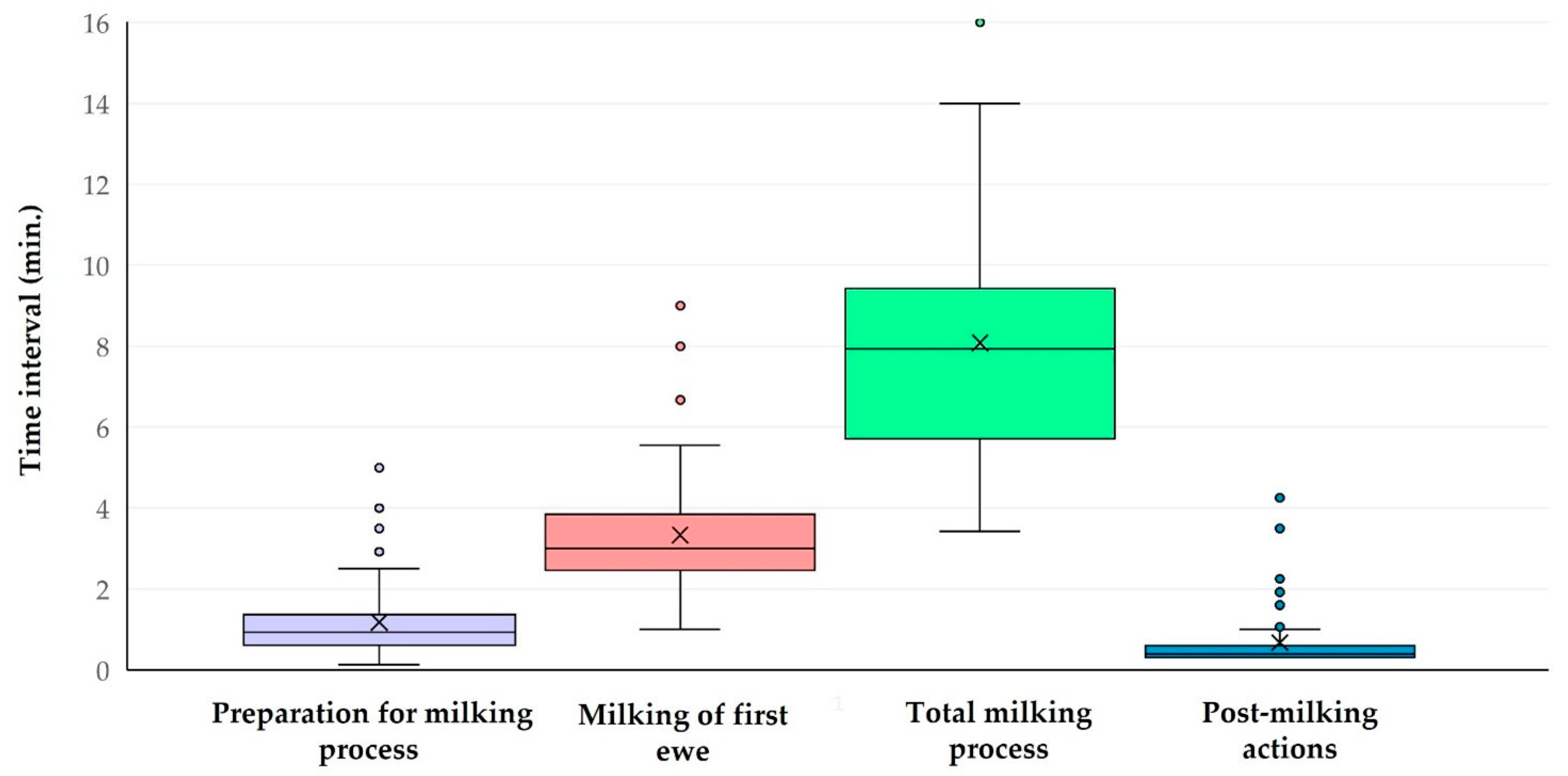
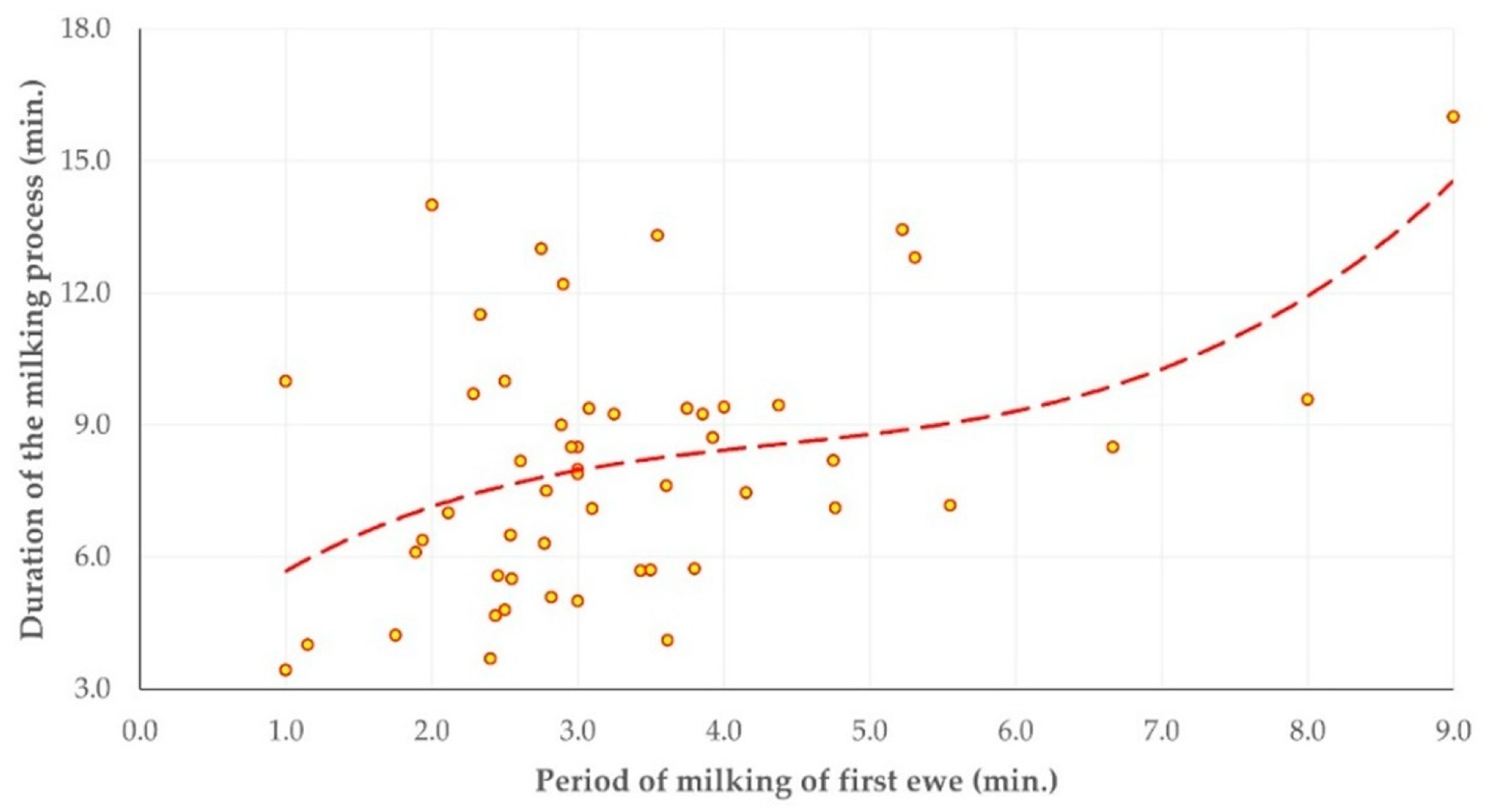
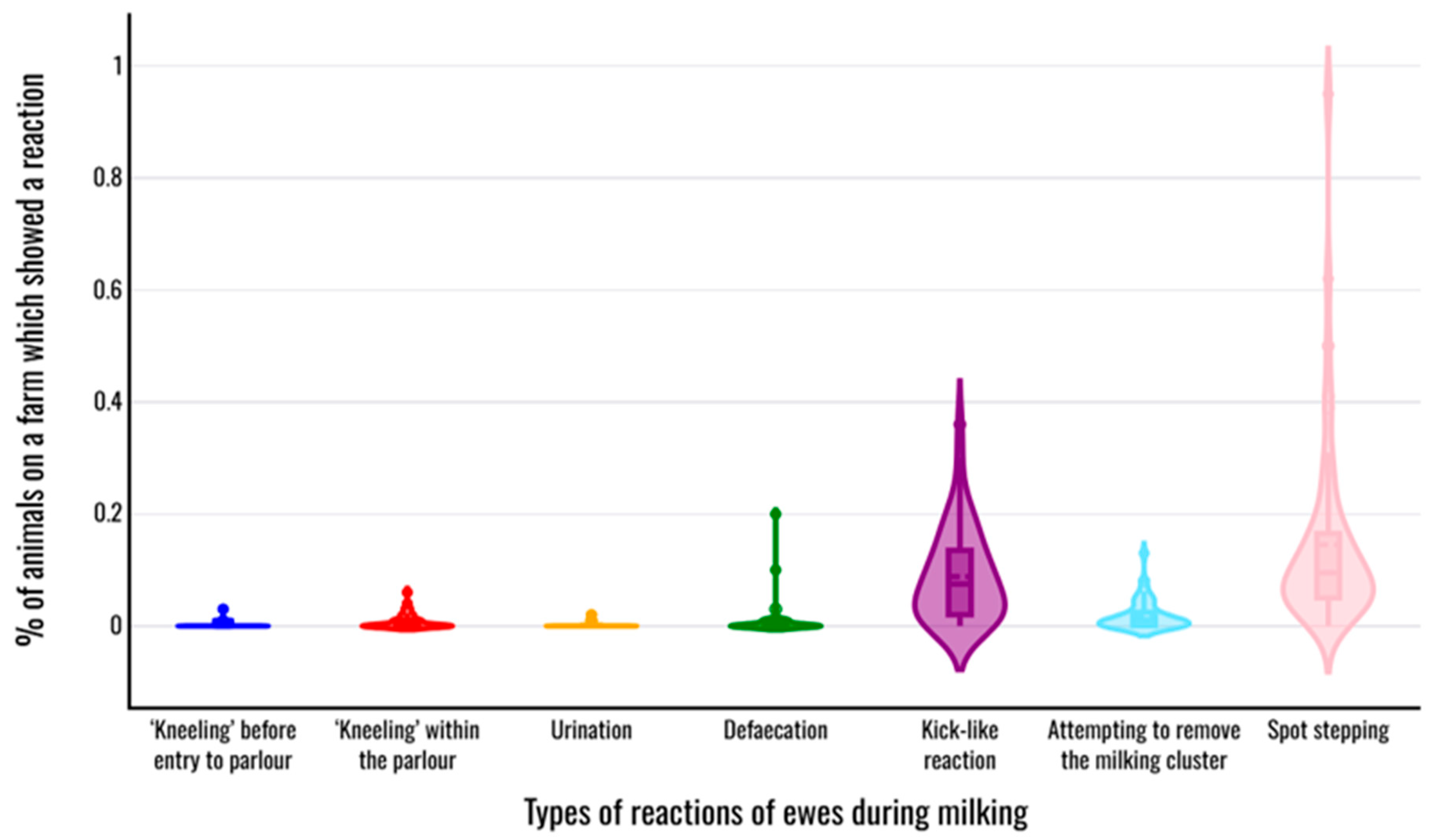
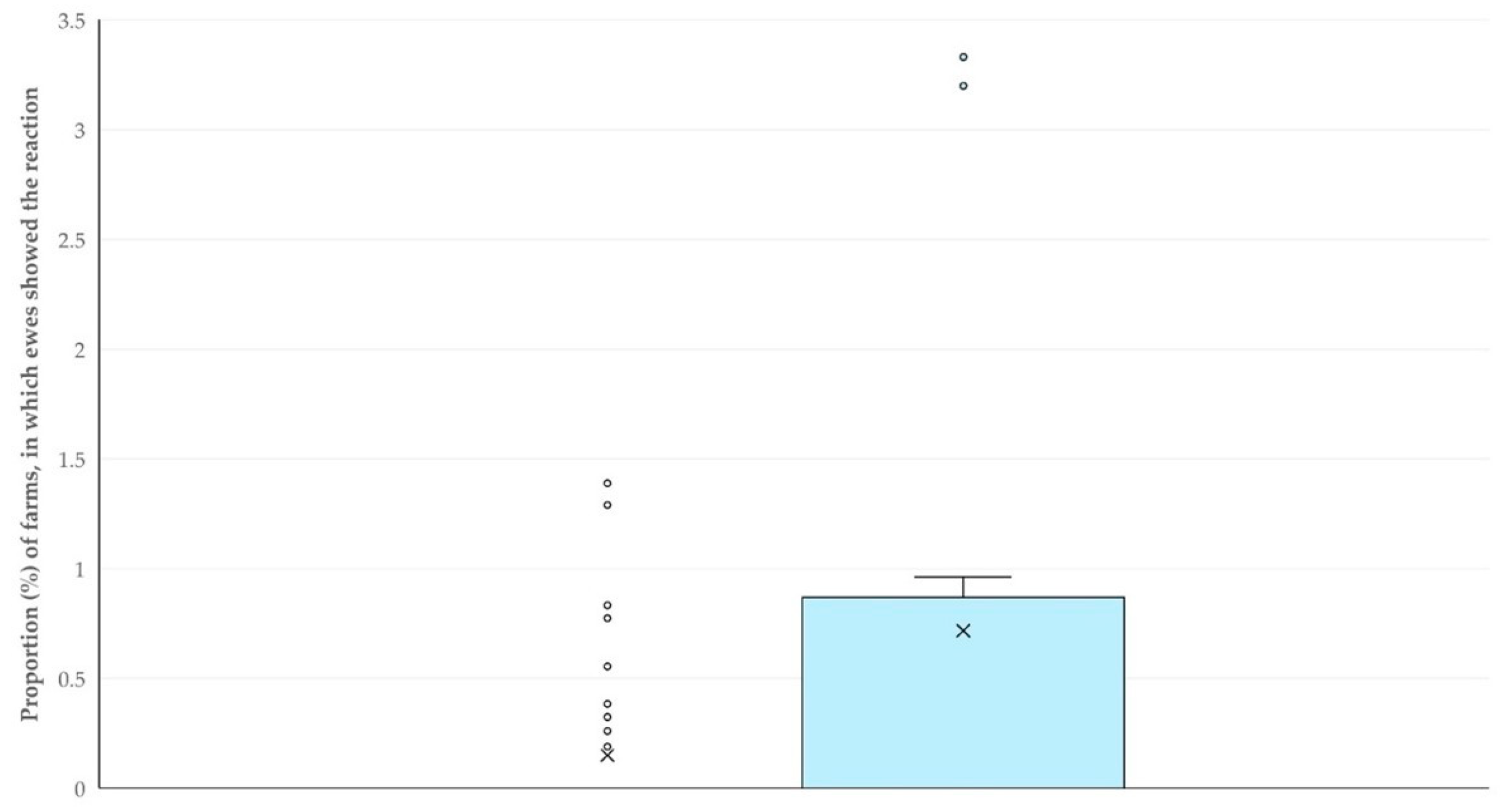
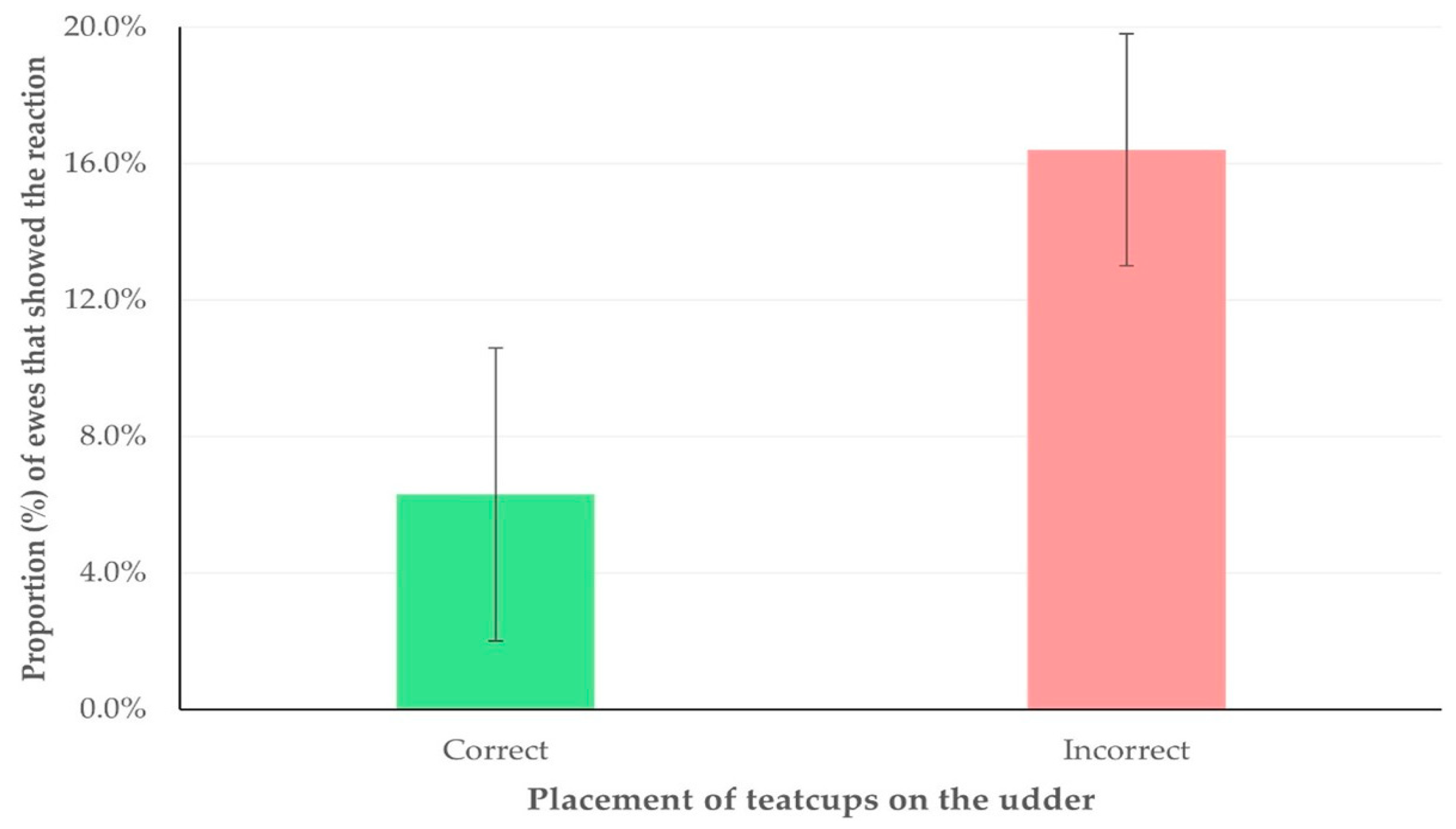
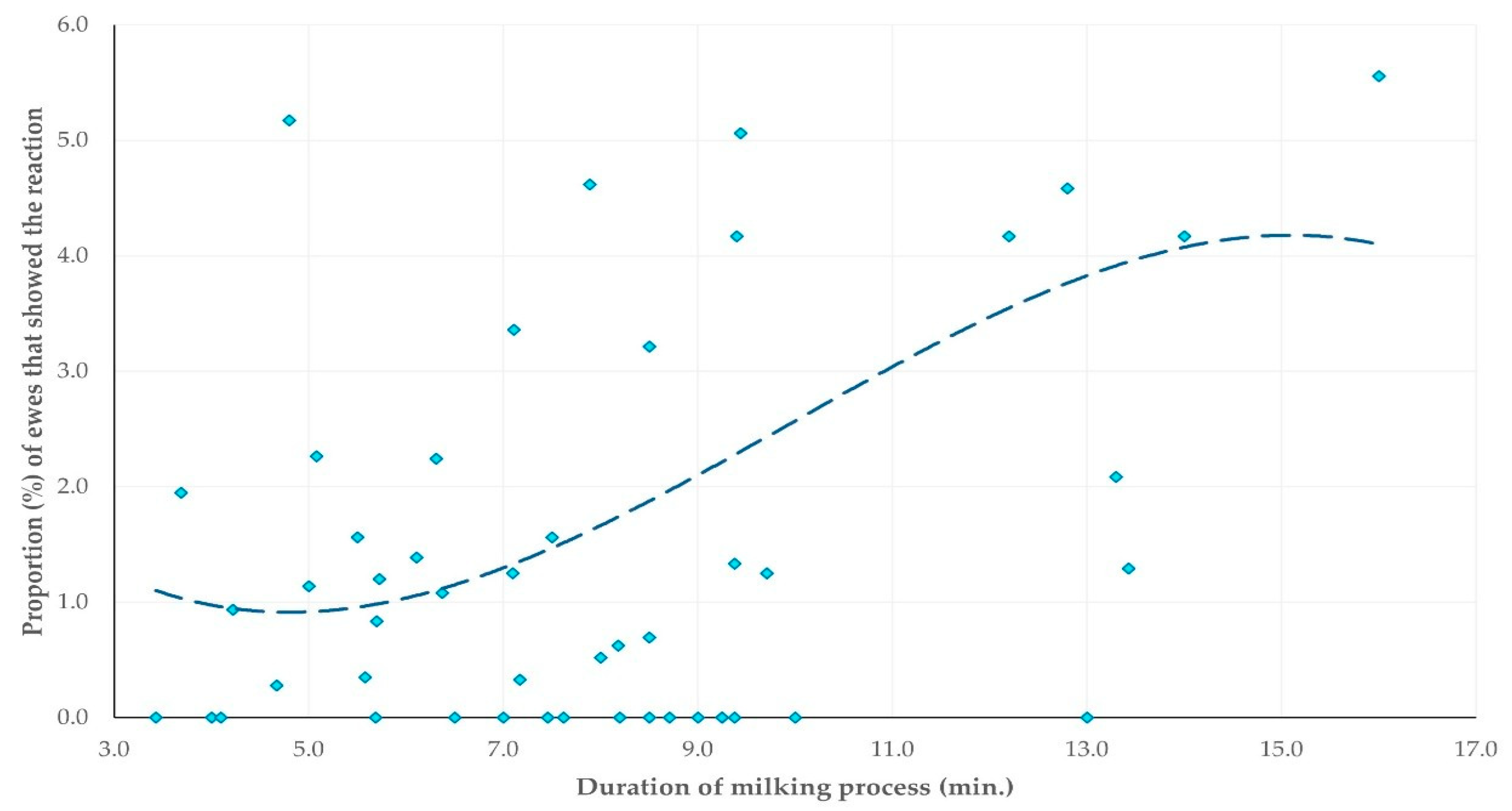
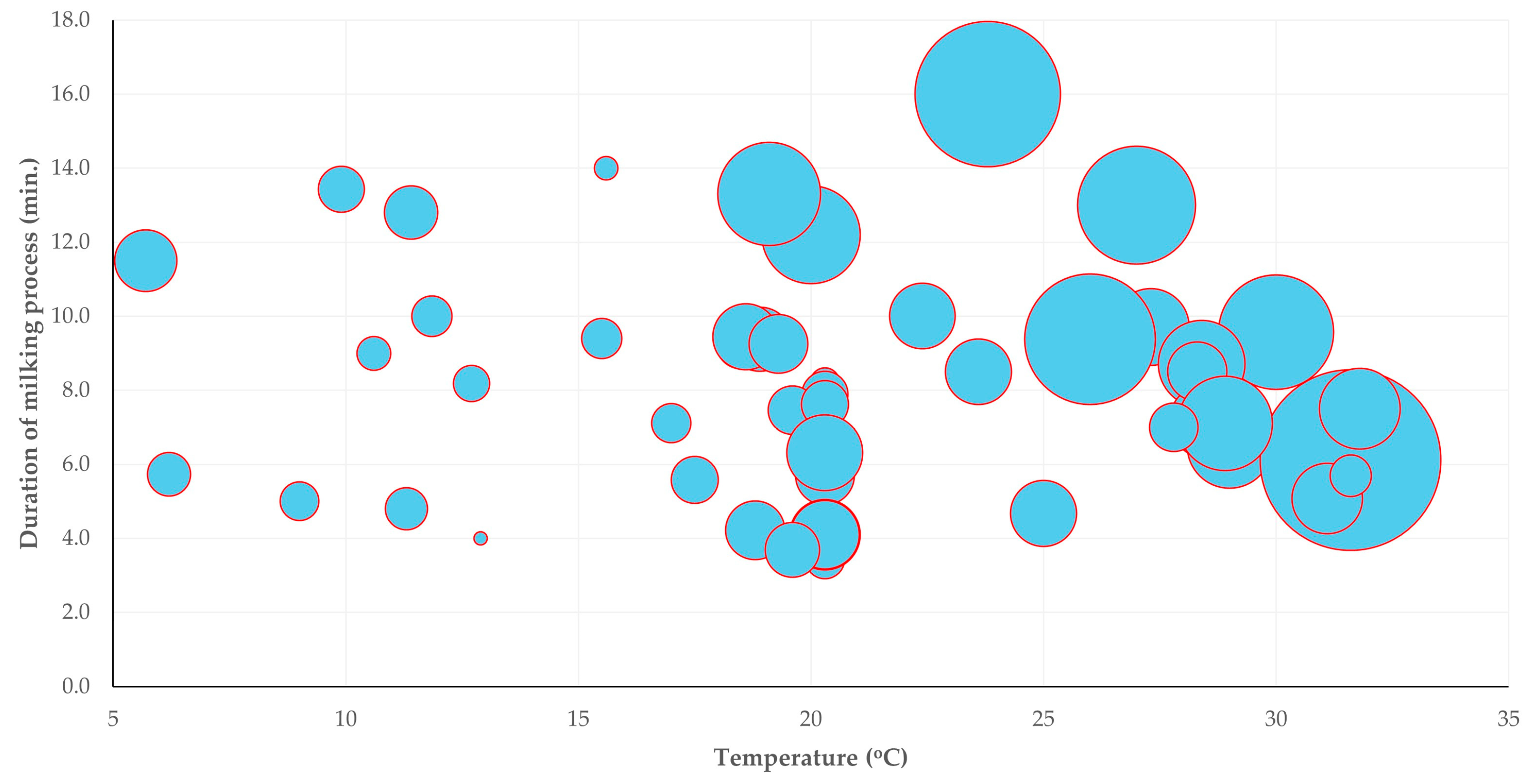
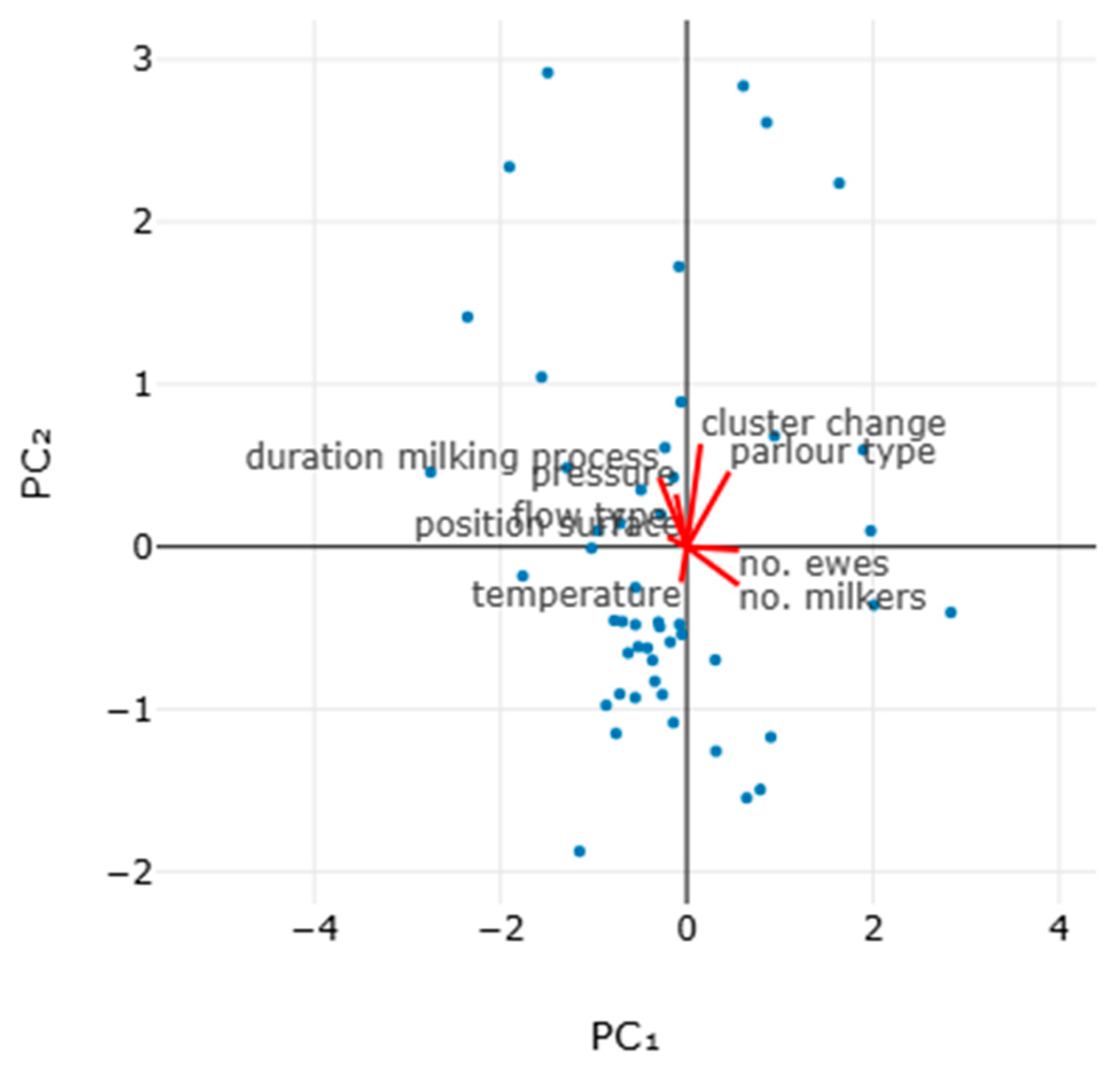
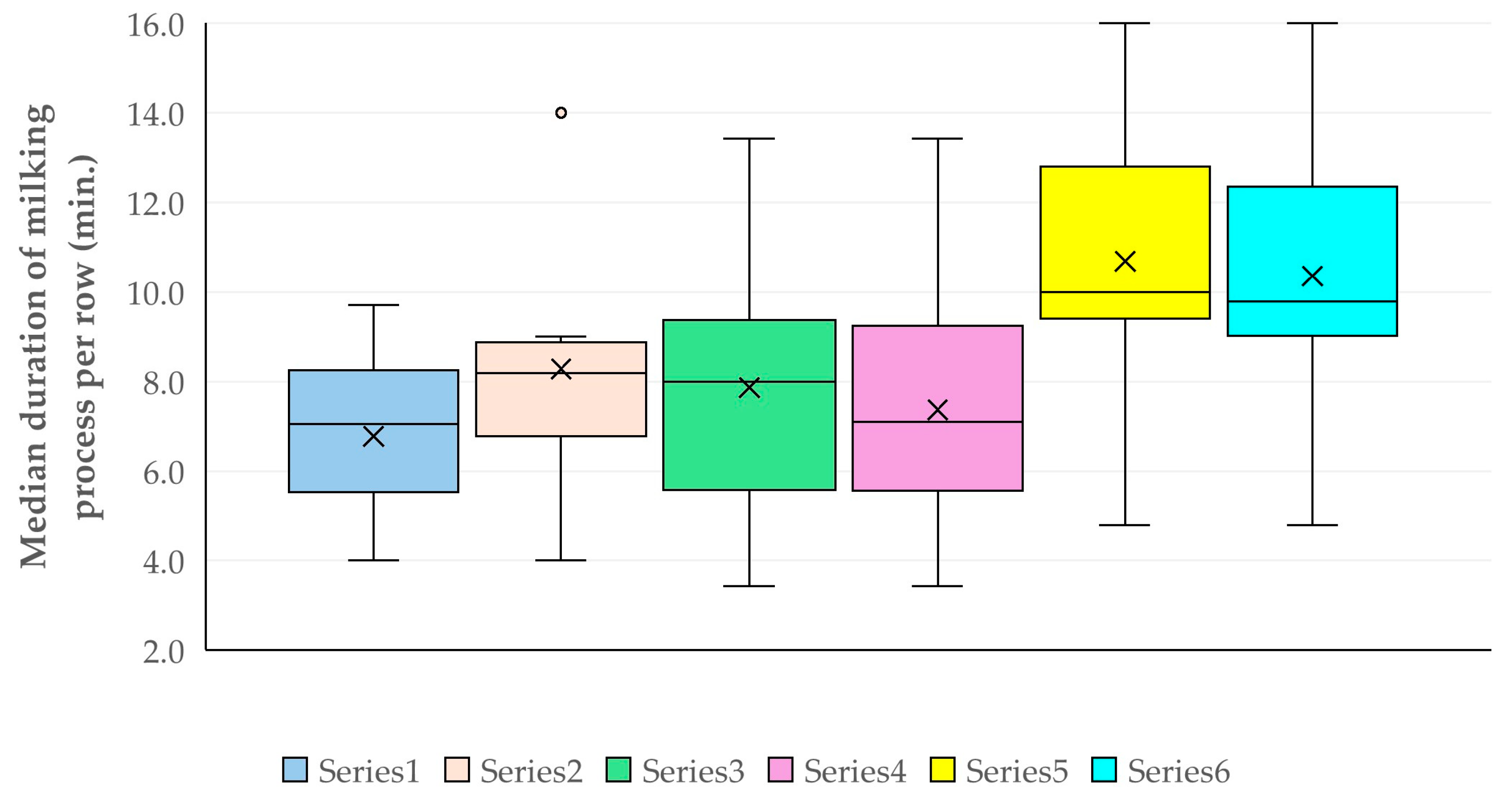
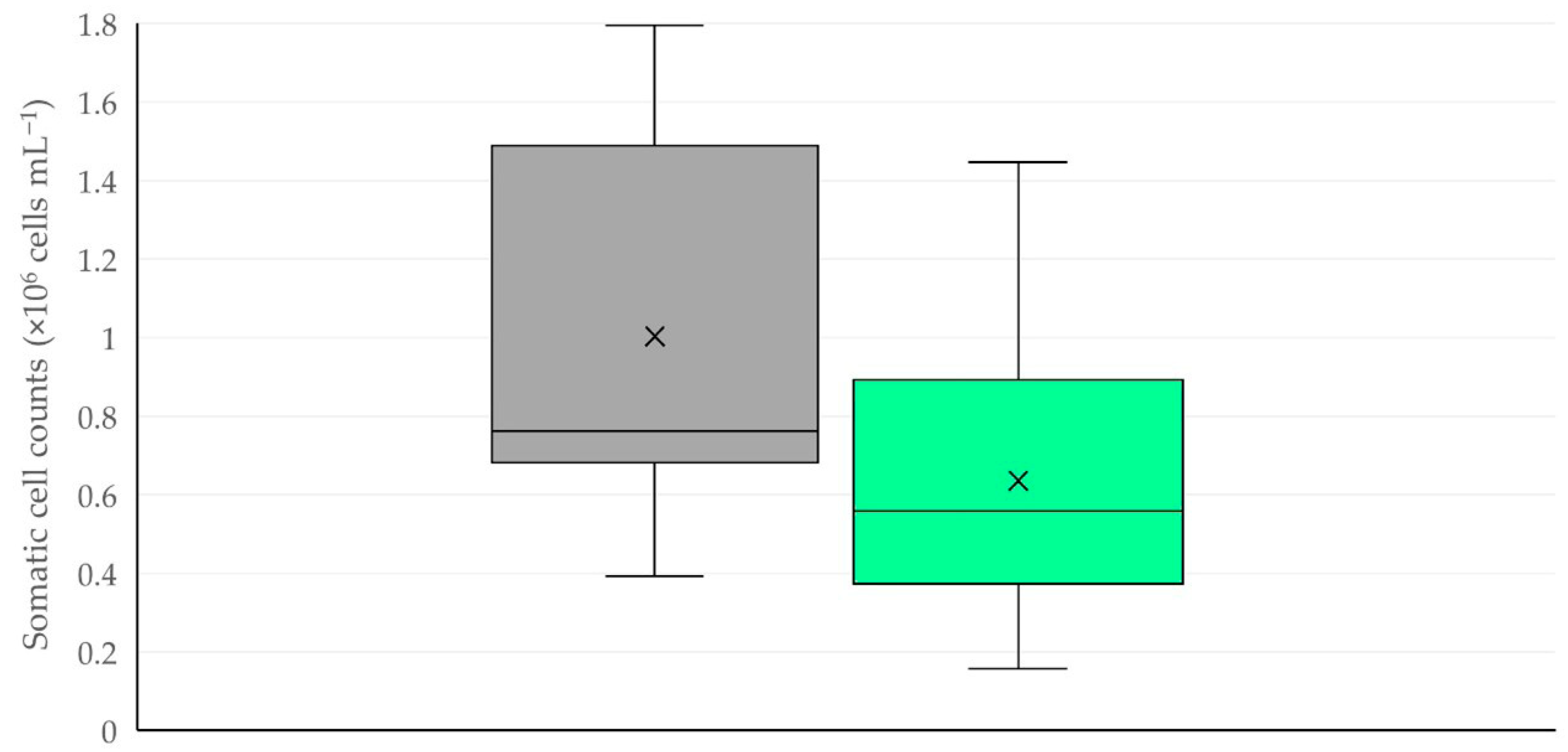
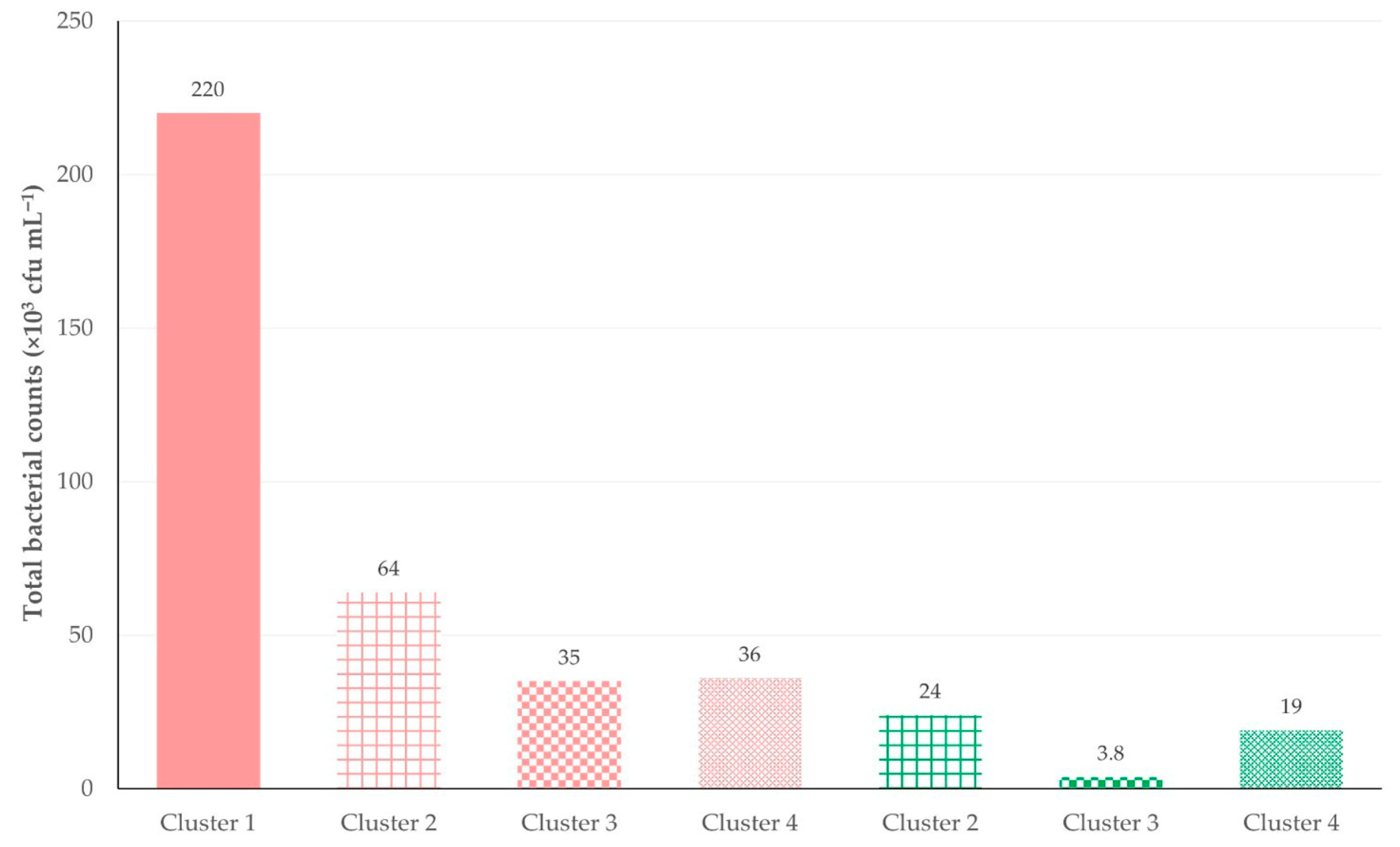
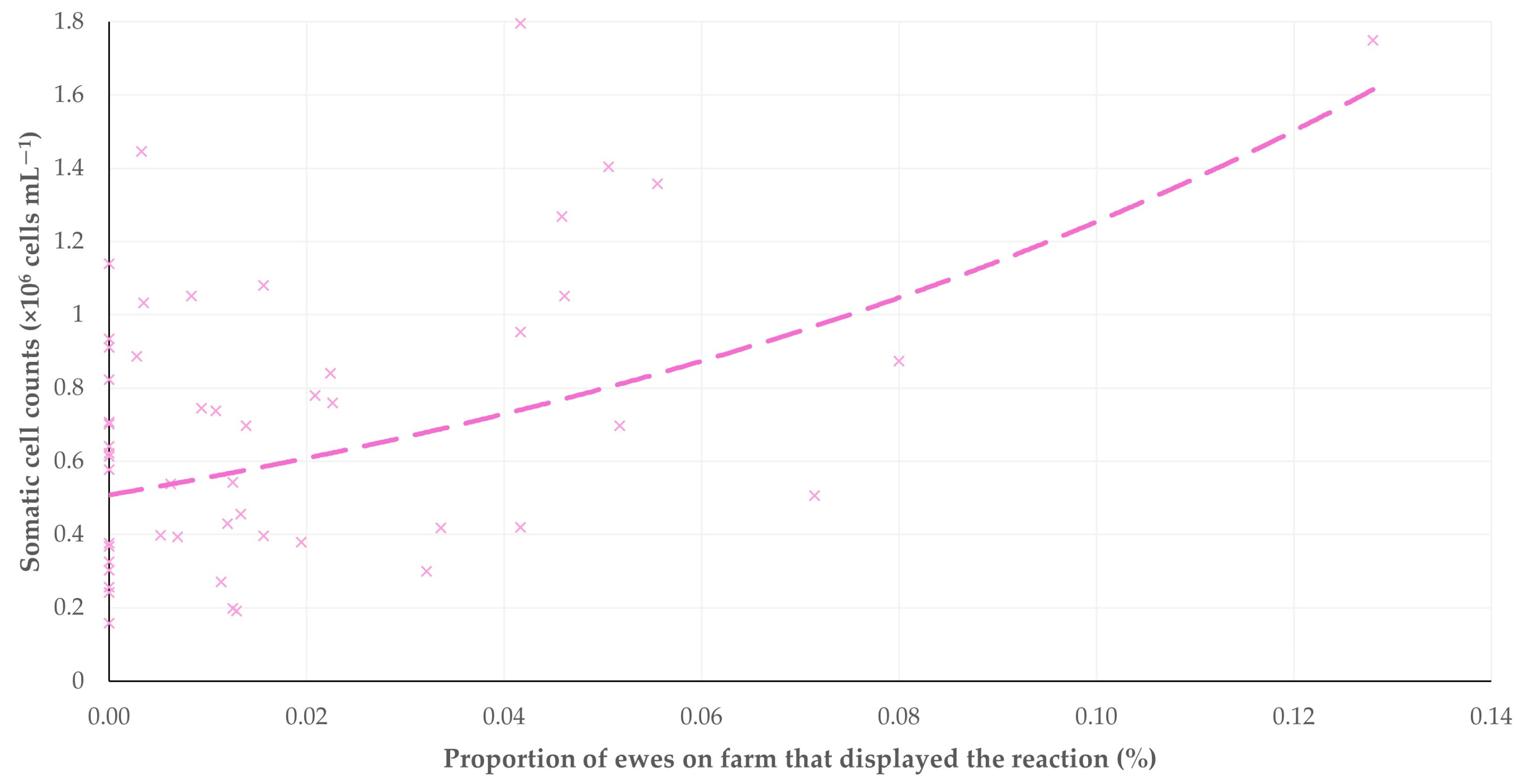
| Time-Event | Description |
|---|---|
| [1] | Ascent of the first ewe of each milking row onto the platform of the parlour, lined up for milking within the parlour |
| [2] | Placement of teatcups on the udder of the first ewe of each milking row (first ewe in the line-up within the parlour) |
| [3] | Removal of teatcups from the udder of the first ewe of each milking row (first ewe in the line-up within the parlour) |
| [4] | Removal of teatcups from the udder of the last ewe of each milking row (last ewe in milking process) |
| [5] | Release of ewes after completion of milking process in the milking row |
| Reaction | Description |
|---|---|
| ‘Kneeling’ before entry to the milking pen | Touching at least one of the joints of the front or rear legs to the floor for at least 2 s, during walking towards the milking parlour |
| ‘Kneeling’ within the milking pen | Touching at least one of the joints of the front or rear legs to the floor for at least 2 s, during the stay at the milking pen (before, during, or after the actual milking) |
| Urination | Urination during the stay at the milking pen (before, during, or after the actual milking) |
| Defaecation | Defaecation during the stay at the milking pen (before, during, or after the actual milking) |
| Vocalisation | Vocal reaction during the stay at the milking pen (before, during, or after the actual milking) |
| Kick-like reaction | Lifting a front or rear foot at least over the carpal/tarsal joint during the stay at the milking pen (before, during, or after the actual milking) |
| Attempting to remove the milking cluster | Touching the milking cluster with a rear foot and attempting to remove it (during the actual milking) |
| Displaying spot-stepping | Displaying walk-like movements of legs, imitating a ‘stationary walking’ (in the milking pen, before, during, or after the actual milking) |
| Start | End | Description |
|---|---|---|
| Within a milking row | ||
| Time-event [1] | Time-event [2] 1 | Duration of animal entrance into milking pens in a milking row (min.) |
| Time-event [2] | Time-event [3] 1 | Duration of milking of first ewe in a milking row (min.) |
| Time-event [2] | Time-event [4] 1 | Duration of milking process in a milking row (min.) |
| Time-event [4] | Time-event [5] 1 | Duration of post-milking actions in a milking row (min.) |
| Within a milking session | ||
| Time-event [1] of first milking row | Time-event [5] of last milking row 1 | Duration of milking session on the farm (i.e., for all milking rows) (min.) |
| Time Intervals 1 | Median Value |
|---|---|
| Period of preparation for milking process in each milking row | 0.9 (0.7 2) min. |
| Period of milking of first ewe in each milking row | 3.0 (1.3) min. |
| Duration of milking process in each milking row | 7.9 (3.7) min. |
| Duration of post-milking actions in each milking row | 0.4 (0.3) min. |
| Duration of milking session on the farm | 105.0 (51.8) min. |
| Reaction | Farms (n), in Which Observed 1 | Median Value Among Farms 2 |
|---|---|---|
| ‘Kneeling’ before entry to the milking pen | 14 (26.9%) | 0.0% (0.2% 3; 0.0–3.3% 3) |
| ‘Kneeling’ within the milking pen | 23 (46.2%) | 0.0% (1.0%; 0.0–6.3%) |
| Urination | 12 (23.1%) | 0.0% (0.0%; 0.0–2.0%) |
| Defaecation | 18 (34.6%) | 0.0% (0.5%; 0.0–20.0%) |
| Vocalisation | 5 (9.6%) | -- 4 |
| Kick-like reaction | 48 (92.3%) | 7.1% (10.9%; 0.0–36.1%) |
| Attempting to remove the milking cluster (or removing it) | 35 (67.3%) | 1.1% (2.5%; 0.0–16.4%) |
| Displaying spot-stepping | 51 (98.1%) | 9.5% (11.3%; 0.0–95.0%) |
| Variables | Relative Risk (95% CI 1) | p |
|---|---|---|
| Availability of a waiting area | 0.026 | |
| availability (n = 40, 0.0% (0.0%) 2) | reference | - |
| no availability (n = 12, 0.0% (0.7%)) | 1.006 (1.002–1.010) | 0.011 |
| Variables | Relative Risk (95% CI 1) | p |
|---|---|---|
| Location of animal-milking positions in relation to work area of milkers | 0.004 | |
| animals on ramp and milkers on ground (n = 23, 0.0% (0.7%) 2) | reference | - |
| animals on ground and milkers in a pit (n = 29, 0.0% (1.7%)) | 1.008 (1.001–1.014) | 0.025 |
| Offering of feed as a means for driving ewes into the animal-milking positions | 0.007 | |
| offering of feed (n = 50, 0.0% (0.9%) 2) | reference | - |
| no offering of feed (n = 2, 1.1% (1.2%)) | 1.011 (1.001–1.021) | 0.043 |
| Variables | Odds Ratio/Relative Risk (95% CI 1) | p |
|---|---|---|
| Location of animal-milking positions in relation to work area of milkers | 0.008 | |
| animals on ramp and milkers on ground (n = 23, 100.0%) | 10.551 (0.552–201.568) | 0.12 |
| animals on ground and milkers in a pit (n = 29, 51.1%) | reference | - |
| Total no. of means used for driving ewes into the animal-milking positions | 0.011 | |
| per unit (means) increase | 1.134 (1.010–1.274) | 0.034 |
| Duration of milking session on the farm | 0.013 | |
| per unit (min.) decrease | 1.002 (0.999–1.004) | 0.06 |
| Variables | Relative Risk (95% CI 1) | p |
|---|---|---|
| Correct placement of teatcups on the udder | 0.019 | |
| Yes (n = 45, 6.3% (8.5%) 2) | reference | - |
| No (n = 7, 16.4% (6.8%)) | 1.097 (1.032–1.166) | 0.004 |
| Variables | Relative Risk (95% CI 1) | p |
|---|---|---|
| Median duration of milking process per milking row | 0.013 | |
| per unit (min.) increase | 1.003 (1.001–1.007) | 0.007 |
| Variables | Relative Risk (95% CI 1) | p |
|---|---|---|
| Temperature in the milking parlour | <0.0001 | |
| per unit (°C) increase | 1.013 (1.006–1.019) | 0.0001 |
| Median duration of milking process per milking row | 0.006 | |
| per unit (min.) increase | 1.016 (1.000–1.032) | 0.05 |
| Early teatcup detachment | 0.014 | |
| Yes (n = 48, 9.0% (9.7%) 2) | reference | |
| No (n = 4, 29.0% (40.2%) 2) | 1.307 (1.111–1.537) | 0.002 |
| Parameter | PC1 | PC2 | PC3 | PC4 | PC5 | PC6 | PC7 | PC8 | PC9 |
|---|---|---|---|---|---|---|---|---|---|
| Eigenvalue | 2.53 | 1.43 | 1.37 | 1.04 | 0.85 | 0.76 | 0.60 | 0.26 | 0.15 |
| % of variance | 28.1 | 15.9 | 15.3 | 11.5 | 9.4 | 8.4 | 6.7 | 2.9 | 1.7 |
| Cumulative variance (%) | 28.1 | 44.0 | 59.3 | 70.8 | 80.3 | 88.7 | 95.4 | 98.3 | 100 |
| Cohorts Defined Based on Displaying a Kick-like Reaction and Attempts to Remove the Milking Cluster | ||||
|---|---|---|---|---|
| Time intervals 1 | A 2 (n = 19) | B (n = 23) | C (n = 10) | p |
| Period of preparation for milking process in each milking row | 0.9 (0.8) 3 | 1.0 (0.7) | 0.8 (1.9) | 0.80 |
| Period of milking of first ewe in each milking row | 2.8 (1.4) | 3.0 (1.1) | 3.5 (2.5) | 0.32 |
| Duration of milking process in each milking row | 7.1 (2.6) | 8.0 (3.7) | 10.0 (3.1) | 0.015 |
| Duration of post-milking actions in each milking row | 0.6 (0.8) | 0.4 (0.1) | 0.3 (0.1) | 0.048 |
| Cohorts Defined Based onDisplaying Spot-Stepping and Attempts to Remove the Milking Cluster | ||||
| Time intervals 1 | A 2 (n = 8) | B (n = 34) | C (n = 10) | p |
| Period of preparation for milking process in each milking row | 1.3 (0.9) 3 | 0.9 (0.8) | 0.8 (1.9) | 0.24 |
| Period of milking of first ewe in each milking row | 2.7 (1.0) | 3.0 (1.2) | 3.5 (2.5) | 0.19 |
| Duration of milking process in each milking row | 8.2 (1.0) | 7.1 (3.5) | 9.8 (2.6) | 0.015 |
| Duration of post-milking actions in each milking row | 0.4 (0.3) | 0.4 (0.6) | 0.3 (0.1) | 0.19 |
| Variables | Relative Risk (95% CI 1) | p |
|---|---|---|
| Congestion of ewes before entry into the milking parlour | 0.047 | |
| Yes (n = 10, 0.763 × 106 (0.635 × 106) cells mL−1 2) | 2.054 (1.160–3.634) | 0.015 |
| No (n = 42, 0.559 × 106 (0.506 × 106) cells mL−1) | reference | - |
| Cluster | n | Variables | Somatic Cell Counts (Cells mL−1) 2 | ||
|---|---|---|---|---|---|
| Facilities for Milk Yield Measurement | Congestion of Ewes Before Entry into mp 1 | Repeat Milking of Ewes | |||
| I | 34 | No | No | No | 0.595 × 106 (IQR: 0.489 × 106) |
| II | 3 | Yes | No | No | 0.417 × 106 (IQR: 0.131 × 106) |
| III | 7 | No | Yes | No | 0.707 × 106 (IQR: 0.281 × 106) |
| IV | 5 | No | No | Yes | 0.934 × 106 (IQR: 0.542 × 106) |
| V | 3 | No | Yes | Yes | 1.749 × 106 (IQR: 0.508 × 106) |
| Variables | Relative Risk (95% CI 1) | p |
|---|---|---|
| Number of animal milking positions for a milking unit | 0.013 | |
| per unit (animal position) increase | 1.072 (0.975–1.178) | 0.15 |
| Post-milking teat disinfection | 0.033 | |
| Yes (n = 10, 18 × 103 (49 × 103) cfu 2 mL−1 3) | reference | - |
| No (n = 42, 62 × 103 (118 × 103) cfu mL−1) | 1.500 (0.982–2.291) | 0.06 |
| Predictors | Animal Reactions |
|---|---|
| Lack of availability of a waiting area before the milking parlour | ‘Kneeling’ before entry to the milking pen |
| Location of animal milking positions in relation to work area of milkers | ‘Kneeling’ within the milking pen |
| Display of vocalisation | |
| No offering of feed as a means for driving ewes into the animal milking positions | ‘Kneeling’ within the milking pen |
| Total no. of means used for driving ewes into the animal milking positions | Display of vocalisation |
| Increased temperature in the milking parlour | Spot-stepping |
| Incorrect placement of teatcups on the udder | Kick-like reaction |
| Avoidance of early teatcup detachment | Spot-stepping |
| Increased duration of the milking process per row | Attempt to remove the milking cluster |
| Spot-stepping | |
| Duration of milking session on the farm | Display of vocalisation |
| Predictors | Characteristics of Milk Quality |
| Number of animal-milking positions for a milking unit | Total bacterial counts |
| Congestion of ewes before entry into the milking parlour | Somatic cell counts |
| Post-milking teat disinfection | Total bacterial counts |
Disclaimer/Publisher’s Note: The statements, opinions and data contained in all publications are solely those of the individual author(s) and contributor(s) and not of MDPI and/or the editor(s). MDPI and/or the editor(s) disclaim responsibility for any injury to people or property resulting from any ideas, methods, instructions or products referred to in the content. |
© 2025 by the authors. Licensee MDPI, Basel, Switzerland. This article is an open access article distributed under the terms and conditions of the Creative Commons Attribution (CC BY) license (https://creativecommons.org/licenses/by/4.0/).
Share and Cite
Liagka, D.V.; Fthenakis, G.C.; Kalonaki, S.N.; Dimoveli, K.S.; Lianou, D.T.; Mavrogianni, V.S.; Michael, C.K.; Caroprese, M.; Spyrou, V.; Vasileiou, N.G.C. Machine-Milking Practices, Animal Welfare-Related Reactions and Quality of Milk Produced in Dairy Sheep Farms. Animals 2025, 15, 3078. https://doi.org/10.3390/ani15213078
Liagka DV, Fthenakis GC, Kalonaki SN, Dimoveli KS, Lianou DT, Mavrogianni VS, Michael CK, Caroprese M, Spyrou V, Vasileiou NGC. Machine-Milking Practices, Animal Welfare-Related Reactions and Quality of Milk Produced in Dairy Sheep Farms. Animals. 2025; 15(21):3078. https://doi.org/10.3390/ani15213078
Chicago/Turabian StyleLiagka, Dimitra V., George C. Fthenakis, Stella N. Kalonaki, Konstantina S. Dimoveli, Daphne T. Lianou, Vasia S. Mavrogianni, Charalambia K. Michael, Mariangela Caroprese, Vassiliki Spyrou, and Natalia G. C. Vasileiou. 2025. "Machine-Milking Practices, Animal Welfare-Related Reactions and Quality of Milk Produced in Dairy Sheep Farms" Animals 15, no. 21: 3078. https://doi.org/10.3390/ani15213078
APA StyleLiagka, D. V., Fthenakis, G. C., Kalonaki, S. N., Dimoveli, K. S., Lianou, D. T., Mavrogianni, V. S., Michael, C. K., Caroprese, M., Spyrou, V., & Vasileiou, N. G. C. (2025). Machine-Milking Practices, Animal Welfare-Related Reactions and Quality of Milk Produced in Dairy Sheep Farms. Animals, 15(21), 3078. https://doi.org/10.3390/ani15213078









